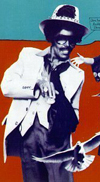For more than forty years, this biased thinking has transformed the once united states of America into a fragmented society that has become completely polarized, and is divided now into tribes ideologically hostile and foreign to each other. A paranoid and stagnant society, ruled by intolerance and blinded by mental calcification born from dogmatic puritanism and political correctness. Nowadays, this society sees the devil everywhere, preferably where it is not. However, truth is that there never was any devil hiding behind Mitchell’s "Art Nouveau" persona, except perhaps for partisan or gullible minds. It is so obvious that by doing what she did, Joni Mitchell only used a transidentity based on gender and skin colour as a creative means to proclaim her fascination (and certainly not her disdain), for everything related to the Afro-American culture. Which spans from what is commonly called "Black Music" to her love for black men, some of them she would romantically be involved with, incidentally. A bright proof of Mitchell's debunked racism and sexism, indeed.
Seriously, how a woman who collaborated with so many black musicians could ever be intentionally mean and disrespectful to the Afro-American people? Clearly, Joni Mitchell paid here for her unconditional free state of mind and her boldness with "Art Nouveau" during this 1976 fancy dress party.
So with hindsight, one can only lament the ridicule and short-sightedness of these ideological attacks disguised as pseudo- sociological analysis. The latter just aiming at disqualifying an independent mindset who always refused categorization in gender, sex, skin color or artistic disciplines. A determination rooted in Moral Universalism, that is precisely what relativist communitarianism hates the most.

"Don Juan’s
Reckless Daughter"
- Album's sleeve (detail) Source: Wikimedia
Yet left apparently undeterred by this paranoia, the singer resurrected her 1977 persona in an unexpected version, in The Beat of Black Wings video (a composition from the Chalk Mark in a Rainstorm 1988 album). But this time, in a much more somber register, even if the new impersonification appeared disguised almost identically, in terms of change of skin color and gender. Regarding the outfit, the Californian pimp’s original attire transmuted into a soldier's army green jacket. In this new composition, the musician evoked a Vietnam veteran named "Killer Kyle", destroyed by the war, and whom Joni Mitchell had briefly met during a concert given at Fort Bragg in North Carolina, in the 1960s. The episode inspired her to make The Beat of Black Wings, a composition as magnificent as it is squeaky and desperate.
Back to the mid Seventies, Joni Mitchell had then gone around the whole circle with the Rock scene. She bifurcated to the sidewalks of Jazz, negotiating a bend towards a narrative poetry tinged with social criticism, and no introspective hues anymore. A move which some of her public, encouraged by the critics, would not forgive. The critics that mattered by then were the American Music medias, because their influence dominated radio airings, which themselves determined the charts and resulting sales, thus ultimately made or broke careers. In the beginning, the critics were reassured by the early "Nice Sister of the Bleeding Hearts", but then got ruffled by the rocker and the man-eater. Next, they would definitely be taken aback in 1975 with The Hissing of Summer Lawns, an album with a content as magical and enigmatic as it is poetic and cruel. The artist abandoned the "I" and the exploration of the soul or romantic relationships to focus on a series of snapshots, often fiercely critical of the American suburbanian lifestyle.
© Jacques Benoit. Design, works, photographies and texts by Jacques Benoit and under the author’s copyright. Except when derived from other sources and then mentioned as such.

